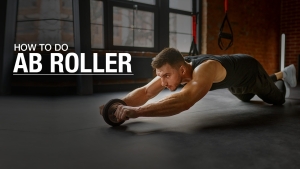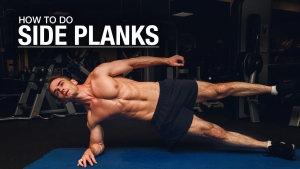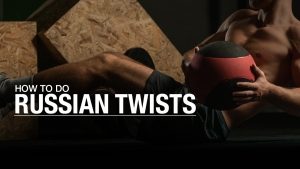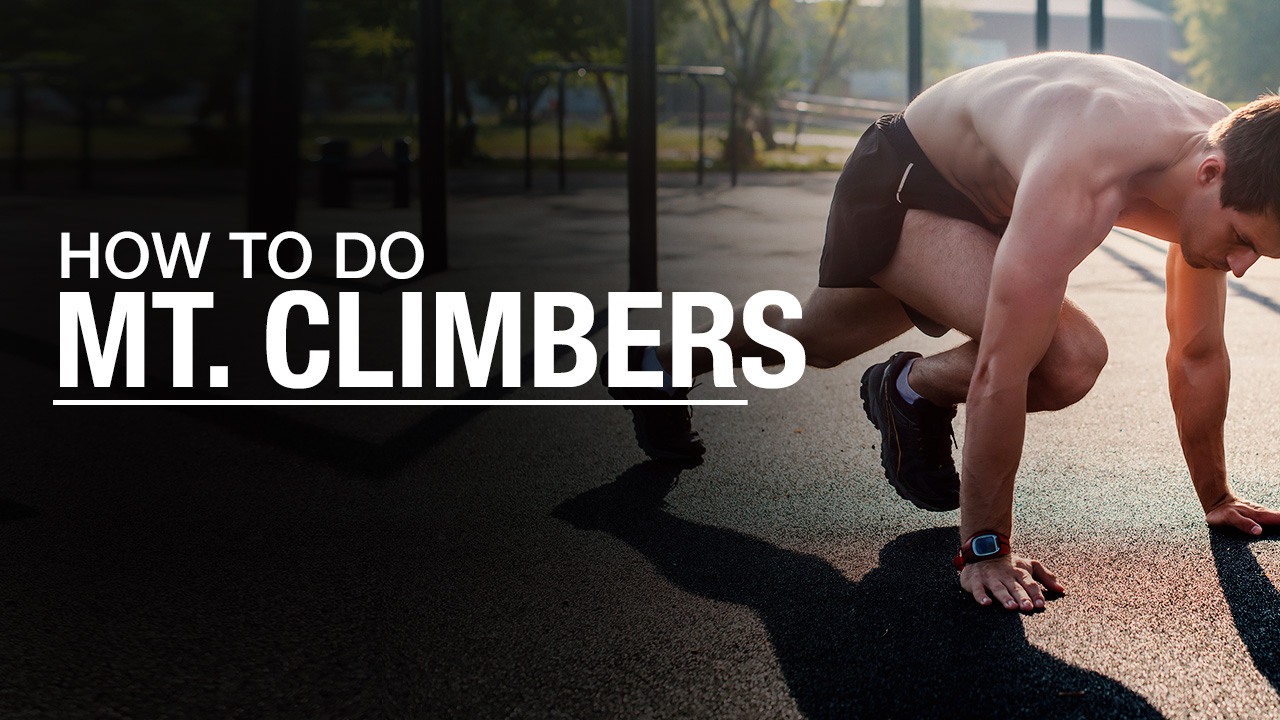
HOW TO PERFORM THE MOUNTAIN CLIMBERS EXERCISE
Guys, question for you: When you’re performing Mountain Climbers, what’s your intensity like?
If you’re doing Mountain Climbers with a lackluster attitude, you’re wasting your time.
The truth is, to get the real benefits of this popular core training move, you need to bring the heat.
It’s not just about going through the motions; it’s about pushing yourself to your limits during this movement.
Today, I’m going to show you how to do the Mountain Climber exercise with perfect form as well as the intensity you need to see results.
But we’re going to vary the intensity because not everyone starts at the same fitness level.
With that said, no matter where you begin, challenging yourself is non-negotiable.
Whether you’re a beginner or an expert, you need to trade extra time for extra intensity.
Here’s how to master the Mountain Climber exercise and truly engage those muscles.
MOUNTAIN CLIMBERS: MUSCLES WORKED
Mountain Climbers are a versatile bodyweight exercise that effectively engages multiple muscle groups, predominantly in the core.
Understanding which muscles are targeted during this exercise is key to maximizing benefits and enhancing your overall workout routine.
By establishing a strong mind-to-muscle connection, you can ensure optimal engagement and performance.
Below, we’ll explore the primary muscles worked when performing Mountain Climbers, highlighting their importance and how they contribute to a strong, stable core.
CORE MUSCLES
The main muscle groups that are activated during the Mountain Climber exercises would be the core musculature.
RECTUS ABDOMINIS


The rectus abdominis is the primary and most prominent muscle in the abdominal area.
Commonly mentioned when talking about the ‘upper abs’ and ‘lower abs,’ these terms actually refer to different sections of the same rectus abdominis muscle, which extends across much of the torso.
It’s the main muscle that forms the iconic six-pack!
The fibers of the rectus abdominis run vertically from north to south, and it is responsible for torso flexion from both top down and bottom up.
This muscle plays a crucial role in many core exercises and workout routines, providing core strength and stability.
Whether you’re performing Mountain Climbers, Pushups, or other traditional ab exercises, the rectus abdominis is constantly engaged, ensuring a tight core and proper form.
Engaging your rectus abdominis correctly can maximize the benefits of your workouts, helping you maintain a neutral position and avoid bad form. It’s essential for effective bodyweight exercises, especially in high-intensity exercise programs and interval training.
EXTERNAL OBLIQUES


The external obliques are fibers that angle diagonally from the sides of the ribcage down to the pelvis.
These muscles are essential for rotation and controlling rotational movements. They add a nice ‘frame’ to the rectus abdominis, enhancing the appearance of the six-pack.
The external obliques play an important role in many core exercises and workout routines, helping to stabilize your body and maintain proper form.
Whether you’re in the starting position of a Plank or performing a knee-to-chest movement in Mountain Climbers, the external obliques ensure your torso stays in position, providing core strength and stability.
Engaging your external obliques correctly can prevent injury and maximize the benefits of your workout.
They are vital for maintaining a neutral position and avoiding bad form during high-intensity exercise and interval training.
INTERNAL OBLIQUES


The internal obliques run in the opposite direction of the external obliques, stretching from the outer edge of the ribcage down toward the hip and angling up and in toward the midline of your body.
These muscles are essential for maintaining core tension and stability during various exercises.
Engaging the internal obliques correctly can prevent common form errors and enhance the effectiveness of your workout.
They provide significant benefits, such as improving your athletic position and overall core strength.
Whether you’re on an exercise mat performing a Plank form or doing Mountain Climbers with a powerful knee drive, the internal obliques help maintain a proper plank position.
TRANSVERSE ABDOMINIS (CORE STABILIZER MUSCLES)

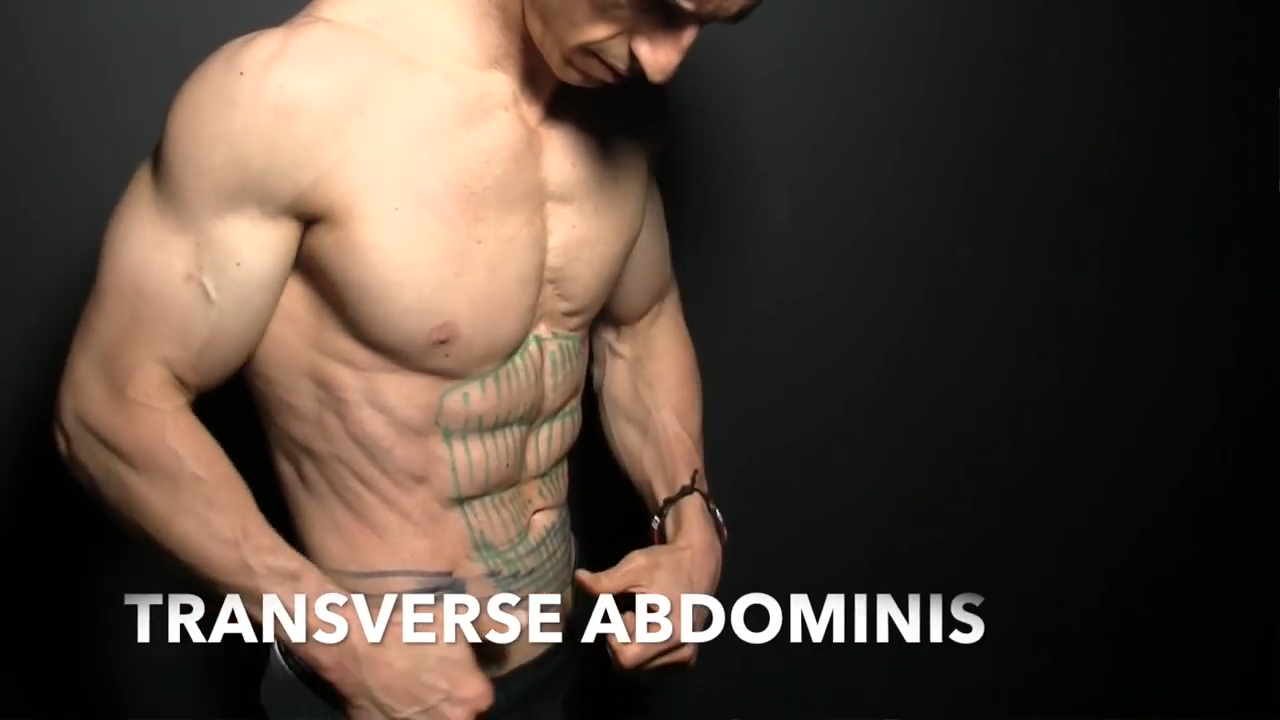
The transverse abdominis runs like a weight belt around your waist and is one of the deepest abdominal muscles and key core stabilizers.
Engaging your abs by drawing them in or doing Ab Vacuums activates the transverse abdominis muscle.
Engaging these deep core muscles is crucial as they help maintain core tension and provide stability for the entire body, especially during difficult exercises and workout routines.
Working the transverse abdominis offers numerous benefits, such as improved core strength, better athletic position, and enhanced performance in a variety of sports.
Including exercises that target the transverse abdominis in your core workout program can reduce the risk of injury, and provide heart health benefits.
This muscle is essential for achieving a balanced and effective bodyweight fitness routine, supporting both your upper body and lower body during versatile exercises and intensity interval training exercises.
SERRATUS

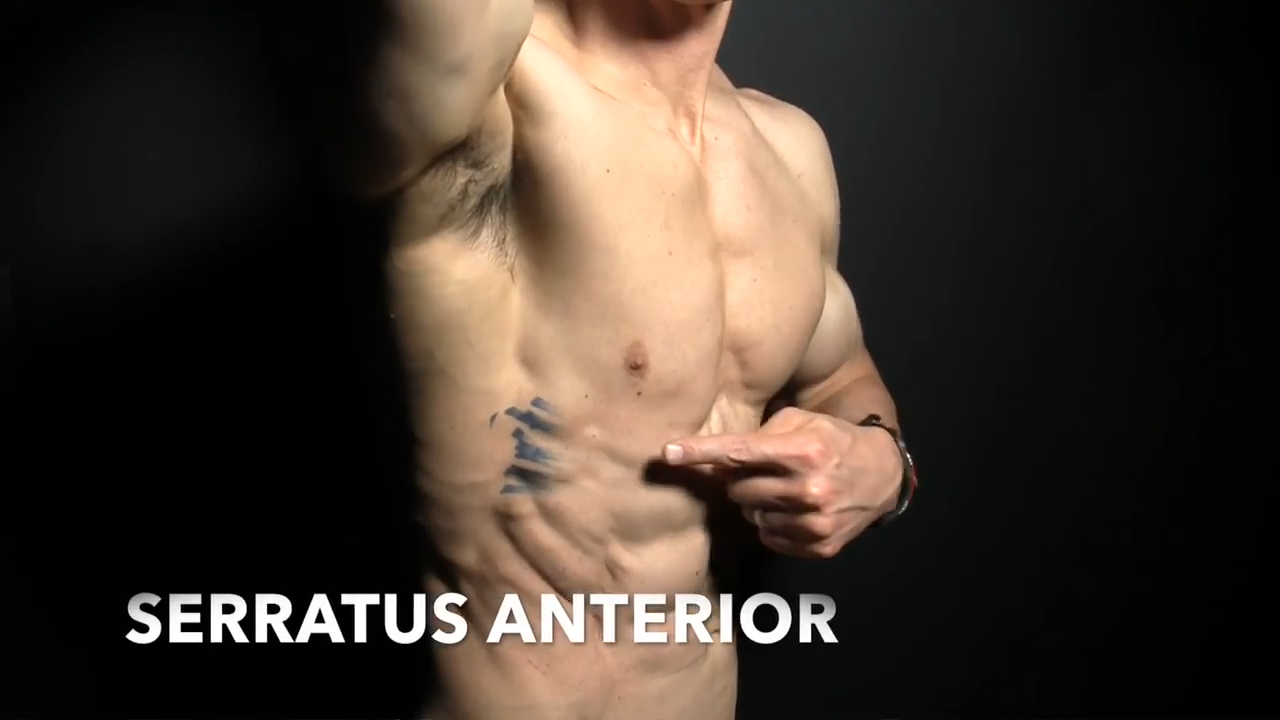
The serratus anterior is an essential muscle that many people overlook or don’t even know exists.
If that’s you, listen up!
This muscle is essential for trunk stabilization, as it ensures the shoulder blades remain connected to the rib cage.
Its fibers are woven together with the oblique fibers, working in tandem to control the rotation of the trunk.
Strengthening the serratus anterior offers numerous benefits, including enhanced shoulder health and upper body stability.
This muscle is vital for maintaining a strong athletic position. Proper engagement of the serratus anterior can prevent form errors and improve your performance in various sports and core workouts.
HIP FLEXORS
It’s easy to take for granted the contribution of our hip flexors during Mountain Climbers, but they play a very important role as they help bring your knees up to your chest.
PSOAS

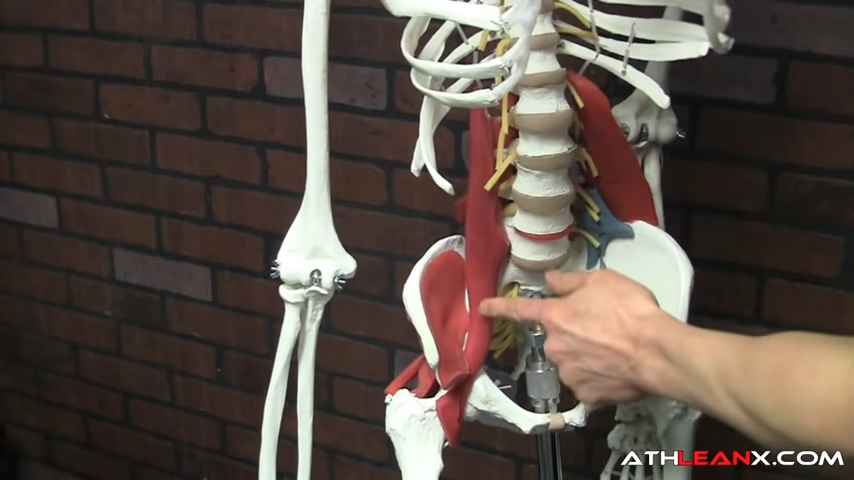
The psoas muscle, a major hip flexor, is crucial in performing Mountain Climbers.
Originating from the lumbar vertebrae and inserting into the femur, it lifts the knee toward the chest, driving the powerful knee flexion essential for this exercise.
In the starting position, with your core muscles engaged and hands under your shoulders, the psoas helps maintain a straight position and proper form.
It works with the core to stabilize the torso, ensuring a neutral position and preventing injury during high-intensity exercises.
Strengthening the psoas enhances core strength and athletic performance, making Mountain Climbers an effective and versatile exercise for any workout routine.
QUADRICEPS
Although the lower body isn’t the primary focus of the Mountain Climber exercise, it plays a significant role in driving the movement, helping to achieve the necessary core contraction.
VASTUS LATERALIS


The vastus lateralis, located on the front of your thigh, helps drive the knee towards the chest during Mountain Climbers, ensuring powerful knee drives and proper form.
In the starting position of a Mountain Climber, with your hands shoulder-width apart on the floor and your body in plank position, the vastus lateralis engages to support the movement.
As you bring your left foot forward and drive your left knee towards your chest, the vastus lateralis contracts, playing a vital role in maintaining core tension and stability.
This muscle works alongside the core muscles and glutes to keep your torso position strong, reducing the risk of injury and improving overall efficiency.
VASTUS MEDIALIS


The vastus medialis, located on the inner front thigh, engages every time you drive your knee towards your chest, maintaining proper form and preventing form errors.
This muscle supports a neutral position and perfect Mountain Climber form, helping to balance your weight and prevent knee injuries.
VASTUS INTERMEDIUS


Just like the other parts of the quadriceps, the vastus intermedius, located beneath the rectus femoris, helps with Mountain Climbers by extending and stabilizing the knee during each drive towards the chest.
RECTUS FEMORIS


The rectus femoris, part of the quadriceps group, is actively engaged during Mountain Climbers by assisting in knee extension and hip flexion.
This muscle helps drive the knee towards the chest and stabilizes the leg, ensuring smooth, controlled movements and proper form.
HAMSTRINGS
When performing Mountain Climbers, turn your attention to the back of your legs, where the hamstring muscles are hard at work. These powerful muscles are divided into two main groups:
BICEPS FEMORIS


The biceps femoris, a key muscle in the hamstrings located at the back of the thigh, is needed for knee flexion and hip extension during Mountain Climbers.
It facilitates smooth and controlled knee drives toward the chest while stabilizing the knee joint and maintaining proper form.
SEMITENDINOSUS


The semitendinosus, part of the hamstring group, assists with knee flexion and hip extension during Mountain Climbers. It stabilizes the knee joint and supports smooth leg movements.
HOW TO DO MOUNTAIN CLIMBERS
This dynamic movement can be adapted for any fitness level, making it a favorite exercise in many workout routines.
Whether you’re a beginner or advanced athlete, mastering the proper form and technique for Mountain Climbers will help you maximize their benefits and avoid injury.
If you’re performing this exercise on a hardwood floor, I’d recommend an exercise mat to cushion your hands.
Here’s a step-by-step guide to performing Mountain Climbers correctly, tailored to three different fitness levels.
MOUNTAIN CLIMBERS FOR BEGINNERS

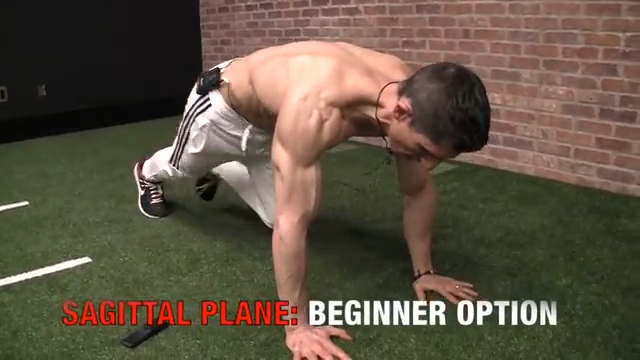
HOW TO DO MOUNTAIN CLIMBERS FOR BEGINNERS:
- Begin in a high plank position with your hands placed directly under your shoulders and your body forming a straight line from your head to your heels. Keep your core engaged to maintain stability.
- Slowly lift your right foot off the floor and bring your right knee toward your chest, stepping it in as far as you can comfortably go.
- Your left leg should remain extended behind you, and your core should stay tight to prevent your hips from sagging.
- Step your right foot back to the starting plank position, ensuring that your body stays in a straight position and your core remains engaged.
- Now, lift your left foot off the ground and bring your left knee toward your chest, stepping it in. Again, make sure your right leg stays extended and your core is tight.
- Step your left foot back to the starting plank position. Maintain the same form and stability throughout the movement.
- Keep alternating each leg in and out, prioritizing controlled and intentional movements over speed.
- Ensure that each step is precise and that you maintain proper form to maximize the effectiveness of the exercise and reduce the risk of injury.
WHAT MAKES IT EFFECTIVE: This beginner version of Mountain Climbers is an effective exercise because it focuses on controlled, deliberate movements that ensure proper form and core engagement, maximizing the benefits while minimizing the risk of injury.
MOUNTAIN CLIMBERS FOR INTERMEDIATE

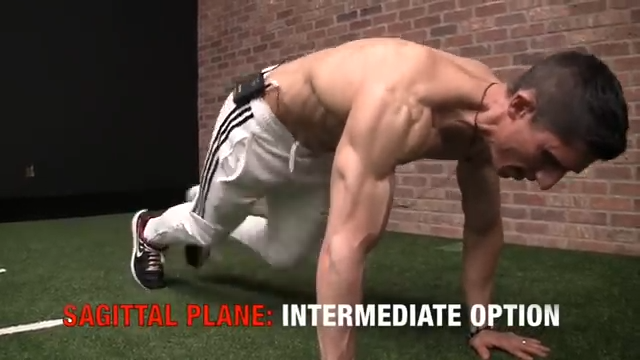
HOW TO DO MOUNTAIN CLIMBERS FOR INTERMEDIATE:
- Get into a high plank position, ensuring your hands are aligned under your shoulders and your body forms a straight line from your head to your heels. Engage your core to maintain stability.
- Quickly lift your right foot off the floor and bring your right knee toward your chest, stepping it in as far as you can comfortably go. Your left leg should remain extended behind you, and your core should stay tight to prevent your hips from sagging.
- As soon as your right foot touches the ground, quickly lift your left foot off the floor and bring your left knee toward your chest, stepping it in. Ensure your right leg stays extended and your core remains engaged.
- Continue to alternate legs rapidly, picking up the pace so that your feet are moving as if you’re jogging in place. Focus on maintaining a steady rhythm and controlled breathing to keep the exercise comfortable and sustainable.
- Throughout the movement, keep your body in a straight line, avoid lifting your hips too high or letting them sag, and maintain core engagement to support your lower back.
- Inhale as one knee comes in, and exhale as the other knee comes in, keeping your breathing steady and controlled to match your pace.
WHAT MAKES IT EFFECTIVE: This intermediate version increases the cardio intensity while maintaining core stability and proper form, leading to improved overall fitness and endurance.
MOUNTAIN CLIMBERS FOR ADVANCED

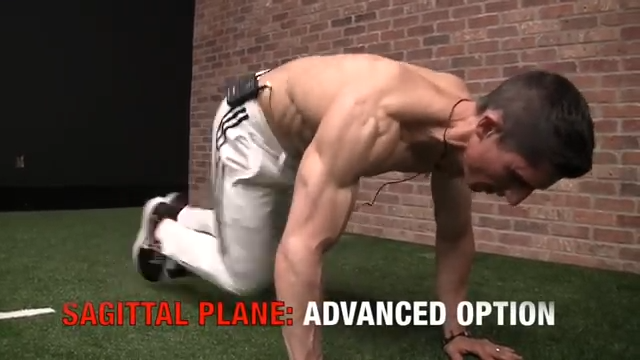
HOW TO DO MOUNTAIN CLIMBERS FOR ADVANCED:
- Assume a high plank position with your hands placed directly under your shoulders and your body forming a straight line from your head to your heels. Engage your core to maintain stability.
- Quickly lift your right foot off the floor and thrust your right knee toward your chest, trying to bring it as close to your hands as you can.
- Your left leg should remain extended behind you, and your core should stay tight to prevent your hips from sagging.
- As soon as your right knee approaches your chest, quickly switch legs by driving your left knee forward and extending your right leg back in a rapid, sprint-like motion.
- Continue to alternate legs at a sprinting pace, aiming to bring each knee as close to your chest as possible with each movement.
- Focus on maintaining a high tempo and driving your knees upward as if performing high knees.
- Maintain a straight body alignment from head to heels during the movement. Keep your hips level, avoiding raising them too high or letting them drop, and engage your core to support your lower back.
- Inhale as one knee comes in and exhale as the other knee comes in, keeping your breathing steady and controlled to match your rapid pace.
WHAT MAKES IT EFFECTIVE: The advanced version is effective because it significantly boosts cardiovascular fitness, core strength, and overall endurance through explosive, high-intensity movements that engage multiple muscle groups simultaneously.
MOUNTAIN CLIMBERS: COMMON MISTAKES
Mountain Climbers are an effective bodyweight exercise that can enhance your cardio fitness, core strength, and overall endurance.
However, to reap the full benefits, it’s crucial to maintain proper form to avoid a mistake with Mountain Climbers.
By avoiding these common mistakes and focusing on proper form, you can maximize the benefits of Mountain Climbers.
This versatile exercise can be incorporated into various workout routines, from core training plans to high-intensity interval training programs, making it a favorite exercise for improving cardiovascular health, core strength, and overall fitness.
Use exercise sliders or different exercise variations to keep your routine challenging and engaging.
POOR STARTING POSITION
Begin in a proper plank position, with your hands placed directly under your shoulders and your body forming a straight line from your head to your heels.
A common mistake is starting with your hips too high or too low, which compromises core engagement and can lead to poor form.
Your starting position sets the tone for the entire exercise, so ensure your form is correct from the beginning to avoid bad form and maximize core-training benefits.
INCORRECT KNEE DRIVE
When bringing your knee toward your chest, ensure that you’re performing a powerful knee drive.
Some users may bring their knee to hip level rather than all the way to their chest, reducing the effectiveness of the exercise.
Aim for a strong knee drive each time to fully engage your core muscles and glutes.
This not only enhances the benefits of the exercise but also helps in improving athletic performance and preventing injury.
LACK OF CORE ENGAGEMENT
Keeping your core muscles tight is essential to maintain stability and prevent lower back strain.
Without a tight core, your torso may sag, increasing the risk of injury.
Focus on core tension throughout the exercise to enhance core strength.
Proper core engagement ensures that you’re getting the most out of your Mountain Climbers, turning it into an effective bodyweight exercise that targets your abdominal muscles and entire body.
SHOULDER POSITIONING
Your shoulders should be stacked over your hands to support your upper body weight.
A common mistake is allowing the shoulders to drift backward or forward, which can strain the shoulder muscles and reduce the exercise’s effectiveness.
Maintaining proper plank form by keeping your shoulders in the correct position helps in preventing shoulder-related injuries and enhances shoulder health, crucial for a variety of sports and workout routines.
UNEVEN WEIGHT DISTRIBUTION
Ensure that your weight is balanced between your hands and feet.
Placing too much weight on your hands can lead to shoulder and wrist discomfort.
Keep a neutral position with an even weight distribution to prevent injury.
Proper weight distribution is key to maintaining a straight position and achieving the core-training, athleticism-boosting benefits of Mountain Climbers.
IMPROPER LEG POSITIONS
When switching legs, maintain a straight position without letting your hips rotate or your body sway.
This helps keep your core engaged and your form strong.
Incorrect leg positions can lead to poor form and reduce the effectiveness of the exercise.
Ensuring proper form in leg positions helps in targeting the correct muscles, including your core, glutes, and legs, making Mountain Climbers a versatile exercise for core strength and cardiovascular fitness.
RUSHING THE MOVEMENT WITH BAD FORM
While Mountain Climbers can be a high-intensity exercise, focusing solely on speed can lead to bad form.
Perform the movements at a pace that allows you to maintain control and proper form.
Rushing can turn this effective bodyweight exercise into a risk for injury.
Instead, focus on controlled, deliberate movements to maximize the exercise’s benefits for your core, upper body, and cardiovascular health.
IGNORING BREATHING
Controlled breathing is vital during high-intensity interval training exercises like Mountain Climbers.
Inhale as one knee comes in and exhale as the other knee comes in to keep your heart rate steady and provide adequate oxygen to your muscles.
Proper breathing techniques enhance the effectiveness of Mountain Climbers by ensuring that your body receives the necessary oxygen to sustain high-intensity exercise, improving overall performance and endurance.
SKIPPING WARM-UP AND COOL-DOWN
Incorporate Mountain Climbers into a comprehensive workout routine that includes a proper warm-up and cool-down to prepare your body for intense movement and reduce the risk of sports-related injury.
Skipping these crucial parts of your workout can lead to increased risk for injury and reduced performance.
A well-rounded cardiovascular program with Mountain Climbers should always include warm-up and cool-down periods to maximize the benefits and ensure long-term fitness and health.
Mountain Climbers are more than a simple step-in and step-out exercise.
Done right, they are an intense way to activate your core focus while torching calories.
It’s one of my favorite exercises and I can’t recommend it enough as a part of a well-rounded core workout.
Don’t have a fully fleshed out type of core workout? We can help with that!
If you’re looking for a training program that covers every muscle in the body as well as the abs, we’ve got you covered. Check out our ATHLEAN-X programs to see which is the best fit for your goals and fitness level.

- The usual Mountain Climber exercise targets multiple muscle groups with a focus on the core.
- Here’s how to perform Mountain Climbers with correct form:
- Start in the position for Mountain Climbers with your hands directly under your shoulders and your body forming a straight line from head to heels. Engage your core for stability.
- Swiftly lift your right foot off the ground and drive your right knee toward your chest, bringing it as close as comfortably possible. Keep your left leg extended behind you and your core tight to avoid hip sagging.
- As soon as your right foot returns to the ground, quickly lift your left foot and drive your left knee toward your chest, ensuring your right leg stays extended and your core engaged.
- Alternate legs rapidly, increasing your pace so your feet move as if jogging in place. Focus on maintaining a steady rhythm and controlled breathing for comfort and sustainability.
- Keep your body aligned in a straight line throughout the movement, avoiding lifting your hips too high or letting them drop. Maintain core engagement to support your lower back.
- Inhale as one knee comes in and exhale as the other knee comes in, keeping your breathing steady and controlled to match your pace.
MOUNTAIN CLIMBERS FAQS
Mountain Climbers are an excellent stationary cardio exercise for your entire body. They primarily target your core, improve your cardiovascular fitness, and boost your body weight fitness.
By engaging your core muscles, you ensure a perfect Mountain Climber form, avoiding common form errors.
Whether you're in a neutral position, incline plank position, or decline plank position, this exercise ramps up your heart rate and strengthens your core.
Mountain Climbers also help with glute recruitment, which is essential for a balanced body weight series of exercises.
You can incorporate them into any cardiovascular program, using pushup handles to enhance foot to plank position transitions.
They're great for improving your performance in a variety of sports and preventing beginner mistakes by building strong foundational fitness.
Mountain Climbers are great for burning belly fat, but let's get real—no single exercise will magically melt fat away.
What they do offer is a high-intensity, full-body workout that ramps up your heart rate and helps you burn calories over time.
By avoiding form errors and focusing on climbers for time, you maximize their fat-burning potential.
Incorporate them into your cardiovascular program and body weight fitness routine for best results.
They engage your core and promote glute recruitment, making them effective for overall fitness.
Pair Mountain Climbers with a fully developed core workout program, balanced diet, and regular exercise, and you'll see those results.
A Mountain Climber exercise is a high-intensity, full-body move that combines cardio exercise and strength training.
Starting in a plank form, with your hands shoulder-width apart and feet hip-width apart, you drive your knees toward your chest one at a time as if you're running horizontally.
This exercise engages your core, glutes, and shoulders while boosting your cardiovascular fitness.
Perfect for torching calories and building functional strength, Mountain Climbers are a staple in any effective workout routine.
Absolutely, Mountain Climbers are a stamina-boosting power move!
When done correctly, with perfect Mountain Climber form, they engage your core, lower body, and shoulders while keeping your heart rate elevated.
By maintaining a consistent rhythm and avoiding form errors, you can turn this exercise into an effective cardio workout.
REFERENCES

Jeff Cavaliere M.S.P.T, CSCS
Jeff Cavaliere is a Physical Therapist, Strength Coach and creator of the ATHLEAN-X Training Programs and ATHLEAN-Rx Supplements. He has a Masters in Physical Therapy (MSPT) and has worked as Head Physical Therapist for the New York Mets, as well as training many elite professional athletes in Major League Baseball, NFL, MMA and professional wrestling. His programs produce “next level” achievements in muscle size, strength and performance for professional athletes and anyone looking to build a muscular athletic physique.

































